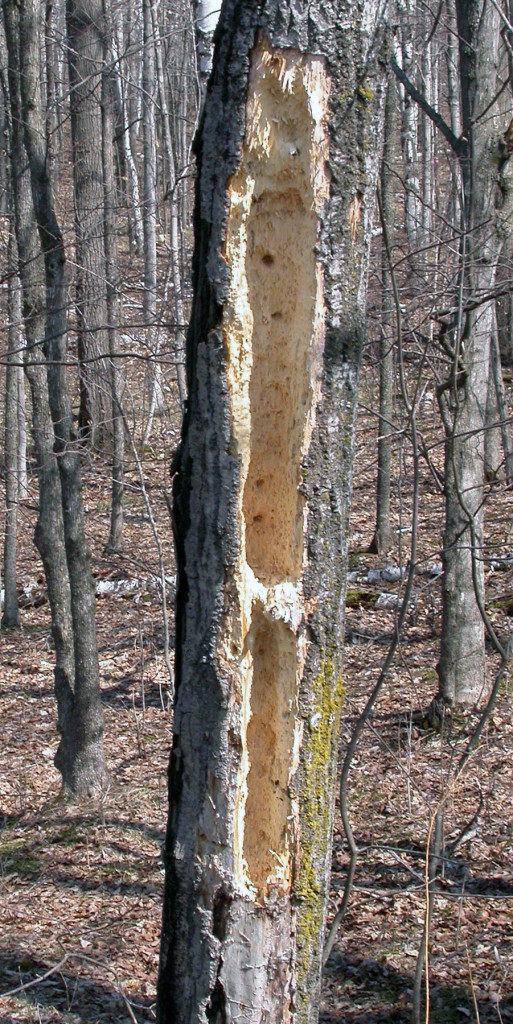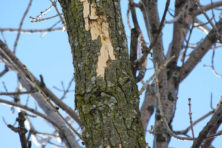Roy Lukes: Pileated Woodpeckers
- Share
- Tweet
- Pin
- Share

Last week I was about to walk into the front yard to fill the bird feeders when a pileated woodpecker produced the most beautiful, loud, resonant “drumroll” from the bottom of the nearby moraine that I’ve ever heard. I paused to listen to his love call two more times before finishing my task.
No sooner had I returned to the house than he swooped across the yard and landed on the marvel meal feeder. He is the boss of all the other woodpeckers in the area and they relinquish their spot at the feeder as he lands. Most often he lands on a nearby ash tree before heading to the suet feeders.
Charlotte and I watched him take chunks out of the packed marvel meal as we noticed a different-than-usual behavior from this welcome guest. Within a half-minute in flew the female, obviously the cause of his uneasy actions. Two enraptured birdwatchers breathlessly observed Mr. and Mrs. Piley show off to each other on the old dead maple tree.
The male flew a short distance to the west while she remained on the maple meticulously examining every crevice and old woodpecker boring. Fortunately we were both carefully watching with binoculars her every move when suddenly her throat swelled and she uttered several vocalizations too faint for us to hear. As though having been called by his mate, in flew the male to renew his courtship antics.

A female pileated woodpecker looks out of her nest hole high in an American beech tree. Photo by Roy Lukes.
Two sounds made by the pileated woodpecker will be commonly heard during the next several weeks, one vocal, and the other non-vocal. The vocal outpouring will consist of a loud, far-reaching “Kuk Kuk Kuk Kuk” sometimes repeated a dozen times in rapid succession.
The non-vocal sound will be the drumming perhaps performed by both the male and the female. Depending upon the type of tree and its firmness, this so-called drumroll can be a very beautiful tone consisting of up to around 32 sharp raps on the tree. They are loudest at the beginning and become softer at the end of the roll.
Whenever I played a tape recording I made of the piley’s drumroll and asked people to estimate the number of strikes within one roll the tendency was to guess too low. I could slow down my four-speed recorder and play it at a speed whereby one could easily count the individual beats. The last time I played it for a group we counted either 32 or 33 strikes within a period of about three seconds.
Almost as though there was some ESP going on between the two of us I look up this second from my writing to see Mr. Piley feasting on the nutty-butter suet block hanging near our sunflower seed feeders. His red crest extends clear to the top of his beak. Hers covers only about the back half of the crown. How meticulously he works at his meal, being quite fastidious to pick at the tiniest pieces. Wariness is his watchword for frequently he pauses to look for predators.
Now he takes off, with several quick wing beats, for the large basswood tree at the corner of the driveway. How effortlessly he soars upward the last several feet for a landing, wings outstretched, revealing the white patches visible on his upper wing surfaces, at the bases of the outer primary feathers.
What a perfect genus name the pileated has, “Dryocopus” (dry-OCK-o-pus), taken from the Greek meaning “tree cleaver.” Its species name is “pileatus” (pie-leh-AY-tus) is based upon the Latin word “pileum” meaning cap.
Nest construction by these crow-sized woodpeckers sometimes begins well before the snow has melted. The nest hole, dug mostly by the female, may take upwards of 30 days to complete. Examine the inside of one and you will agree that it is quite a work of art, not rough and slivery as you might expect but rather smooth to the touch.

This tree shows a large feeding hole of a pileated woodpecker. Photo by Roy Lukes.
Don’t confuse a feeding excavation with a nest hole entrance. I’ve seen where a pileated woodpecker, in its quest for carpenter ants and wood-boring beetles, made holes that were six inches wide, at least that deep and as much as three feet long. The nest entrance is usually rectangular in shape and approximately 3½ inches by 4 inches in size. The inside cavity will average about 19 inches deep.
It is said that all woodpeckers construct their own roosting cavities which are used only by them night after night. The belief is that some, including the pileated may have more than one roosting hole. Roosting means it is just a place for shelter, not a nesting site.
Many observations have confirmed the fact that older unused pileated nesting and roosting cavities are taken over and used as nest holes by wood ducks, common goldeneye ducks, common flickers, eastern screech owls, crested flycatchers and other species of birds. Add to this list flying squirrels, and now you realize the great importance of the pileated’s house-building for other wildlife.
I was asked recently by someone who is seeing these huge woodpeckers quite regularly, how you distinguish the male from the female. We talked earlier of the difference in the red crest of each. Another notable feature is the “mustache” patch extending from the base of the bill backward, which is entirely black on the female. The male’s mustache patch contains red feathers, best seen in good light conditions.
The pileated woodpecker has to be one of the most sought after “lifers” of all birds seen by birdwatchers, a lifer being one’s very first bona fide sighting of a particular species. Perhaps it’s due to the approximately 250 miles of shoreline plus a high number of mature mixed hardwood forests that make Door County a very good area for seeing these fascinating woodpeckers. Observations by many ornithologists over the years indicate that the pileated does prefer to nest within close proximity to water or wetlands.
What amazes me is their prodigious appetite for carpenter ants. A scientific study that entailed collecting three adult pileated woodpeckers discovered a total of 6,680 carpenter ants in their stomachs! Surely these awesome birds must be of considerable value to trees.
We come upon the unmistakable excavations of the pileated much more frequently than we see the excavator itself. Here’s to the master carpenter of all U. S. birds, the gold medal winner, the pileated woodpecker!

